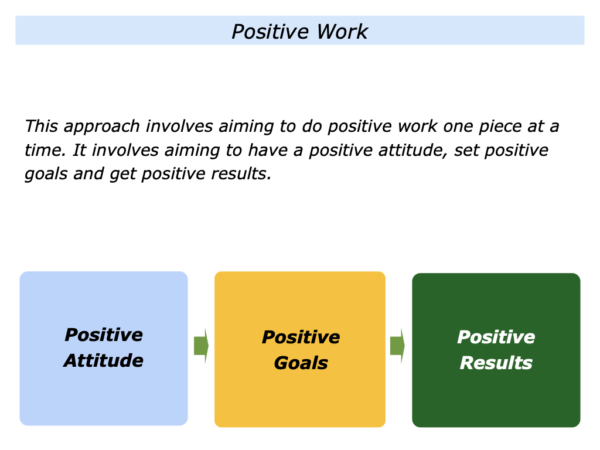
There are many ways to do fine work. One approach involves aiming to do positive work one piece of work at a time. This could be work that helps people or the planet.
Different people follow this approach in different ways. Some people take the following steps:
They clarify the principles they want to follow in their life;
They clarify how they can follow these principles by doing specific kinds of work;
They clarify the specific piece of work they are going to do – whether in the next hour, day, work, year or another period – and then aim to follow their principles when doing this piece of work.
Different people follow this the path in different situations. They may be aiming to stay sober, do creative work or do another activity. They aim to have a positive attitude, set positive goals and get positive results. Let’s explore this approach.
Doing One Piece Of Work At A Time
When Working In A Care Home
This is an approach I learned in my early twenties when doing full-time voluntary work in a UK Leonard Cheshire Care Home. This meant caring for older people when:
Waking them up … Giving them breakfast … Taking them to the toilet … Finding out about their lives … Listening to their memories … Feeding them meals … Being kind every moment of the day … Putting them to bed.
This provided a great grounding. It taught me to be present and do my best to encourage people. This approach proved helpful many years later when I was often doing six mentoring sessions during a day.
Doing One Piece Of Work At
A Time When Designing Change
Kiran Bir Sethi has encouraged many young people to do positive work that helps people or the planet. She founded the Riverside School in Ahmedabad and the global movement Design For Change.
This inspires thousands of children to focus on implementing their ideas for building a better world. Here is an excerpt from its website.
Children and adults can shape their futures by moving from saying “Can I?” to “I Can.”
They can find something that bothers them, do something about it and make change happen. They can do this by following the design process of Feel, Imagine, Do and Share.
Children are dreaming up and leading brilliant ideas all over the world.
They are implementing ideas from challenging age-old superstitions in rural communities, to earning their own money to financing school computers to solving the problem of heavy school bags.
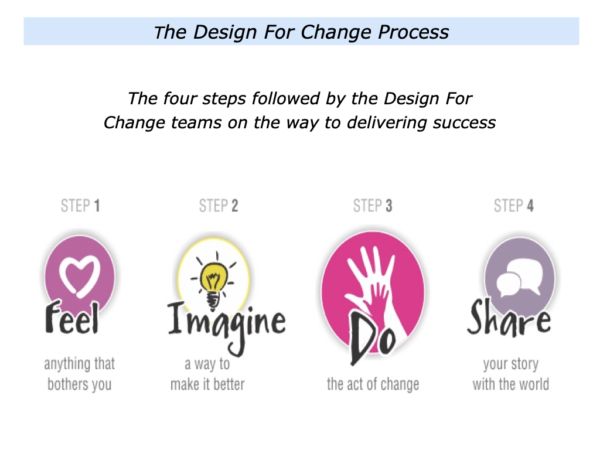
Children focus on challenges on their own doorstep. They may aim to clean local rivers, convert garbage dumps into playgrounds, ensure school friends can get home safely, care for the elderly or do other activities.
Kiran has a background in design. She and her colleagues therefore invite children to tackle challenges by going through the design process of Feel, Imagine, Do and Share.
Feel
Focus on something you feel strongly about. This could be something that bothers you or something you want to improve. Start to explore your desired picture of success.
Imagine
Imagine a way to make it better. Explore what good looks like and search the world for examples of best practice. Focus on what you can control and clarify your picture of success.
Do
Do the necessary work. This can be an eye-opener for some young people, because it calls for sweat and overcoming setbacks on the road to achieving success. One student described this in the following way.
This part taught us to develop persistence. Our generation is used to having a short attention span and, if we get bored, moving on to the next idea.
But we realised that you have to be persistent to make change happen. That taught us a lot.
Share
Share your story with the world. The students make videos of their work and also take part in the annual Design For Change School Challenge. These stories provide inspiration for others who want to achieve their pictures of success.
Kiran explains how this approach is helping young people to develop the skills necessary for shaping the future. She describes this in the following way.
The Feel, Imagine, Do, Share framework helps to develop the much required 21st Century Skills in children. It builds their social and emotional competencies and promotes employability skills.
The power of Design Thinking allows both children and adults to transform the world into how they envision it – the power to create a more compassionate, empathetic world.
Doing One Piece Of Work At A Time When
Working To Achieve Peak Performance
This is an approach followed by some people who follow their passion, pursue their principles and achieve peak performance. They may do this when working as artists, athletes, leaders or in another role.
Chris Hoy, the Olympic cyclist, took this approach. He began by setting big goals. Breaking these down into smaller targets, he focused on the step-by-step process of working to achieve these aims. This included visualising and riding the perfect race.
Chris gave an interview to Michael Johnson, who himself won four Olympic gold medals, for the video series Chasing Perfection.
In it he explained what he learned from working with Steve Peters, the psychiatrist who helps people to perform at their best. Here is a precis of what Chris said.
I sought Steve’s help because I wanted to improve. One trigger was what happened at the World Championships in 2003. Then I changed my strategy based on watching a rival’s race and them doing an incredibly fast time.
Instead of thinking that he was quick because of the track conditions – and therefore maybe we would all be quick – I changed the gears on my bike. I also attacked too hard at the start. This led to me dying off at the end and giving a really poor performance.
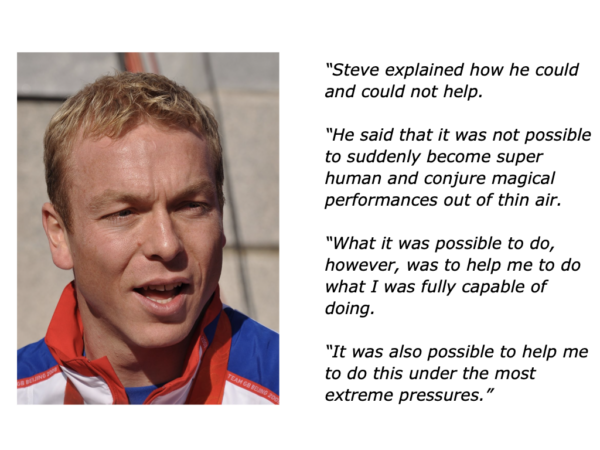
This would be particularly relevant in front of Olympic crowds where there might also be many distractions. For me it would be about focusing on my performance. Anything that was irrelevant and out of my control, forget it.
The key would be hone in on the process that I knew worked rather than worry about the outcome. If you perform at your best and focus on the process, the result will take care of itself.
He also describes how Steve prepared him to deal with potential challenges. Before one competition, for example, Steve asked him what he would do if one of his rivals went just before him and set a new world record.
Chris said that he did not want to think about such an issue. Steve explained that it was important to clarify how to respond to such challenges rather than ignore them.
Otherwise it is like somebody saying: “Don’t think of a pink elephant.” You immediately think of a pink elephant.
Steve urged him to practice how to take positive steps to deal with such potential issues. Chris explained this in the following way.
Steve said that, from now on whenever you get a negative thought between now and the Games – there are only two weeks to go – I want you to visualise your race.
It is only a minute long. Do it in real time, from the moment you are at the start gate. The countdown, the deep breaths, the snap out of the gate, the first half lap. Visualise the whole race.
I got to the race on the night itself and it seemed like Steve had some sort of crystal ball. I was to ride last. With four riders to go, including myself, the guy broke the world record.
Three riders to go another guy broke the world record. The guy before me broke the world record again.
Instead of panicking and changing my strategy, I was so focused on myself and getting my ride out.
He went on to ride his perfect race. He focused on the process, performed at his personal best and won the prize. This was a process he followed when winning further Olympic medals.
Chris followed similar principles after being diagnosed with terminal prostate cancer. Here is a summary of what he said when releasing a video about his approach.
You may have heard by now that I’m ready to share that my cancer is stage four. I will be living with it for the rest of my life.
Now it’s not the news anyone imagines hearing and it obviously came as a huge shock.
We have taken time to process it as a family and I now have a deep resolve to turn this incredibly difficult diagnosis into something more positive, that can help not just me, but anyone anywhere living with stage four.
I’ve made the decision to write about it all in a book. You might wonder why I take on writing a book during such a challenging time.
It’s been cathartic and it’s a very important part of how I’ve been able to process this news with my family and for myself over the past few months.
I wanted to share this in the hope that it might help others in challenging situations too.
I hope it can provide not only an insight into how a family deals with a diagnosis like mine, but also remind us that all we have is now. Not the past, not the future, but where we are in this moment.
It’s about hope, how I lost it after the diagnosis and how I found it again.
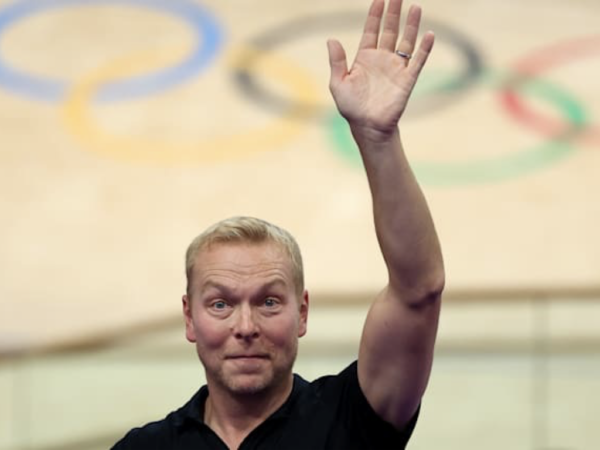
There are many ways to do fine work. One approach involves aiming to do positive work one piece at a time. It is to have a positive attitude, set positive goals and get positive results.
Looking ahead, can you think of a situation where you may want to follow elements of this approach. This could be in your personal or professional life. How could you follow this in your own way?
If you wish, try tackling the exercise on this theme. This invites you to complete the following sentences.
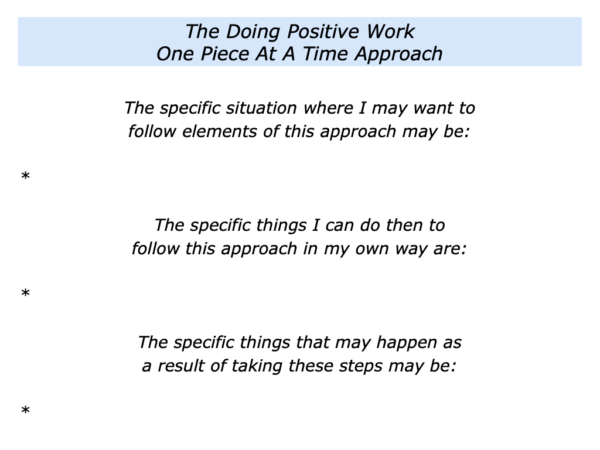


Leave a Reply